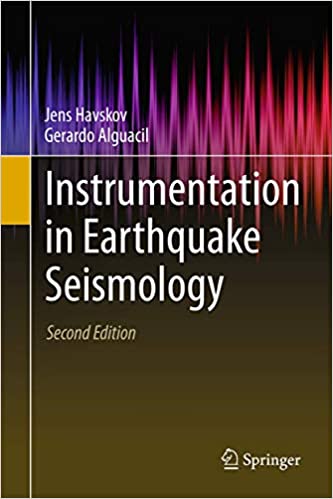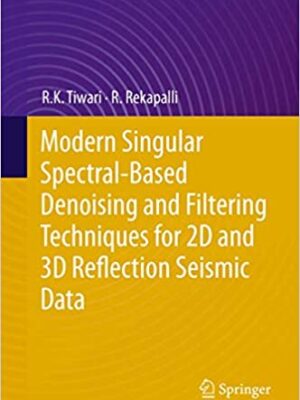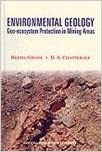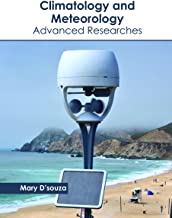Instrumentation in Earthquake Seismology
Original price was: ₹10,372.95.₹8,298.36Current price is: ₹8,298.36.
ISBN: 9783319213132
Author/Editor: Jens Havskov
Publisher: Springer
Year: 2016
1 in stock (can be backordered)
Description
This work provides an up-to-date overview of modern instruments used in earthquake seismology as well as a description of theoretical and practical aspects of seismic instrumentation. The main topics are:
* Choosing and installing equipment for seismic stations
* Designing and setting up seismic networks and arrays
* Maintaining and calibrating seismic instruments
It also provides detailed descriptions of the following:
* Seismic sensors
* Digitizers
Product Properties
| Year of Publication | 2016 |
|---|---|
| Table of Contents | CHAPTER 1 Introduction 1.1 Sensor 1.2 Recorder 1.3 Stations and networks 1.4 Arrays 1.5 Instrument correction and calibration CHAPTER 2 Seismic sensors 2.1 The standard inertia seismometer 2.2 Seismometer frequency response 2.3 Seismometer frequency response, alternative solution 2.4 The velocity transducer 2.4.1 Electromagnetic damping 2.4.2 Polarity convention 2.5 Instrument response curves, different representation 2.6 Sensor response to transient signals 2.7 Damping constant 2.8 Construction of seismic sensors 2.8.1 The Wood Anderson short period torsion sensor 2.8.2 Long period sensors 2.8.3 Garden-gate 2.8.4 Inverted pendulum 2.8.5 LaCoste 2.8.6 Rotational seismometer 2.9 Sensor calibration coil 2.10 Active sensors 2.11 Accelerometers 2.12 Velocity broadband sensors 2.13 Extending the frequency response, inverse filtering and feed back 2.14 Theoretical aspects of active sensors 2.14.1 General response of a feedback system 2.14.2 The basic Force-Balanced Accelerometer 2.14.3 Broadband feedback seismometers 2.14.4 Servo velocity sensors 2.14.5 Other feedback techniques 2.15 Sensor self noise 2.16 Noise in passive sensors coupled to amplifiers, theoretical aspects 2.17 Some new trends in seismic sensors 2.17.1 Seismometers with electrochemical transducers 2.17.2 Micromachined accelerometers and seismometers 2.17.3 Piezoelectric sensors 2.18 Sensor parameters 2.18.1 Frequency response 2.18.2 Sensitivity 2.18.3 Sensor dynamic range 2.18.4 Sensor linearity 2.18.5 Sensor cross axis sensitivity 2.18.6 Sensor gain and output 2.18.7 Sensor adjustments 2.19 Examples of sensors 2.19.1 Exploration type 4.5 Hz geophone 2.19.2 Short period sensorS 2.19.3 Accelerometer, the Kinemetrics Episensor 2.19.4 Broadband sensors 2.19.5 Negative feedback sensors, Lennartz LE-3D 2.19.6 Borehole sensors 2.20 Summary of sensor specifications 2.21 Which sensor to choose CHAPTER 3 Seismic noise 3.1 Observation of noise 3.2 Noise spectra 3.3 Relating power spectra to amplitude measurements 3.4 Origin of seismic noise CHAPTER 4 Analog to digital converter 4.1 Example of a simple analog to digital converter, the Flash ADC 4.2 Basic ADC properties 4.3 A typical ADC, the ramp ADC 4.4 Multi channel ADC 4.5 Digitizers for a higher dynamic range 4.6 Oversampling for improvement of the dynamic range 4.7 Sigma Delta ADC, SDADC 4.7.1 How sigma-delta improves digitization noise: theory 4.8 Aliasing 4.9 Anti alias filters 4.10 Dynamic range, different definitions 4.11 Examples of digitizers CHAPTER 5 Seismic Recorders 5.1 Analog amplifier 5.1.1 Differential input-output 5.2 Analog filters 5.2.1 Amplifier specifications and noise 5.3 Analog recording 5.4 Introduction to digital recorders 5.5 Digitizing 5.6 Time stamping of data 5.7 Storage media and recording in a ring buffer 5.7.1 The SEED format 5.7.2 Ring buffer 5.7.3 Naming seismic channels 5.8 Seismic triggers 5.9 Summary of trigger parameters and their settings 5.10 Communication and data retrieval 5.11 Public domain data acquisition systems 5.12 Seismic recorders in use 5.14 Examples of recorders 5.15 Which recorder to choose CHAPTER 6 Correction for instrument response 6.1 Linear systems 6.2 Spectral analysis and the Fourier transform 6.3 Noise power spectrum 6.4 General instrument correction in frequency and time domain 6.5 General representation of the frequency response function 6.6 Anti alias filters 6.7 Instrument correction and polarity 6.8 Combining response curves 6.9 Common ways of giving response information 6.9.1 GSE 6.9.2 SEED 6.9.3 SAC 6.9.4 SEISAN 6.9.5 How to make and maintain response files CHAPTER 7 Seismic stations 7.1 Geographical location of a seismic station 7.2 Site selection and seismic noise survey 7.3 Installation of the seismic station 7.4 Sensor installation 7.4.1 Broadband sensor installation 7.4.2 Borehole installations 7.4.3 What is a good VLP station 7.5 Temporary installation of seismic stations 7.6 Lightning and over-voltage protection 7.7 Power 7.7.1 Stations running off the main AC supply 7.7.2 Batteries 7.8 Power sources 7.8.1 Solar cells 7.8.2 Wind generators 7.8.3 Fuel cells CHAPTER 8 Seismic networks 8.1 Purpose of seismic networks 8.2 Network geometry 8.3 Network configuration: Physical and virtual networks 8.4 Physical network with fixed transmission links 8.4.1 Communication standards 8.5 Virtual seismic networks 8.6 Offline virtual seismic networks 8.7 Seismic data transmission 8.8 Analog data transmission 8.9 Radio links 8.9.1 Simplex-duplex 8.9.2 Point to point or point to multi point radio networks 8.9.3 Spread spectrum 8.9.4 Radio link construction and equipment 8.9.5 Radio links with repeater stations 8.10 Telephone and satellite 8.11 Digital data transmission protocols and some examples of their use 8.11.1 Serial data communication 8.11.2 TCP/IP communication 8.11.3 Compression of digital data 8.11.4 Error correction methods used with seismic signals 8.11.5 Seismic data transmission and timing 8.11.6 Remote control, Communication and graphics 8.12 Examples of networks 8.13 Running a seismic network 8.13.1 Physical operation 8.13.2 Data processing 8.14 How to make your own permanent network CHAPTER 9 Seismic Arrays 9.1 Basic array parameters 9.2 Array transfer function 9.3 Instruments characteristics 9.4 Field arrangement 9.5 Example of a portable array CHAPTER 10 Calibration and testing 10.1 Test equipment and recording of test signals 10.2 Sensors 10.2.1 Sensor free period 10.2.2 Seismometer damping 10.2.3 Determining calibration coil motor constant 10.2.4 Polarity and sensor orientation 10.2.5 Frequency response using harmonic drive methods 10.2.6 Lissajous figures 10.3 Methods for absolute calibration of a sensor 10.3.1 Shaking table 10.3.2 Using the ground as a shaking table 10.3.3 Calibration by stepwise motion 10.3.4 Determining sensitivity of accelerometer by tilt 10.4 Use of the calibration pulse 10.4.1. Using pseudo random signals for calibration 10.5 Recorder 10.6 Dynamic range measurement 10.7 Measuring instrument self noise 10.8 Measuring ground resolution of a given recorder-passive sensor combination APPENDIX I Basic electronics A.1 Basic terms A.1.1 Electric charge A.1.2 Electric potential, current and power A.1.3 Kirchhoff laws A.2 Passive components A.2.1 Resistors, inductors and capacitors A.2.2 Connection of components in series and parallel A.2.3 A passive non-linear component: the diode A.3 DC and AC signals A.3.1 Decibels A.3.2 Complex impedances and response A.4 Power supply A.5 Common laboratory instruments A.6 Amplifiers A.6.1 Basic amplifier configurations A 6.2 Active filters A 6.3 Switched capacitors integrator A.7 Introduction to logical circuits A.7.1 Example: A daily calibration sequence generator for seismometers. APPENDIX II Company references Index |
| Author | Jens Havskov |
| ISBN/ISSN | 9783319213132 |
| Binding | Hardback |
| Edition | 2 |
| Publisher | Springer |
You must be logged in to post a review.






Reviews
There are no reviews yet.